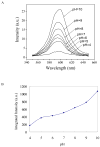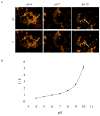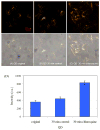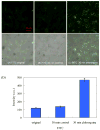pH-sensitive Photoluminescence of CdSe/ZnSe/ZnS Quantum Dots in Human Ovarian Cancer Cells
- PMID: 18985164
- PMCID: PMC2577287
- DOI: 10.1021/jp0654718
pH-sensitive Photoluminescence of CdSe/ZnSe/ZnS Quantum Dots in Human Ovarian Cancer Cells
Abstract
The photoluminescence of mercaptoacetic acid (MAA)-capped CdSe/ZnSe/ZnS semiconductor nanocrystal quantum dots (QDs) in SKOV-3 human ovarian cancer cells is pH-dependent, suggesting applications in which QDs serve as intracellular pH sensors. In both fixed and living cells the fluorescence intensity of intracellular MAA-capped QDs (MAA QDs) increases monotonically with increasing pH. The electrophoretic mobility of MAA QDs also increases with pH, indicating an association between surface charging and fluorescence emission. MAA dissociates from the ZnS outer shell at low pH, resulting in aggregation and loss of solubility, and this may also contribute to the MAA QD fluorescence changes observed in the intracellular environment.
Figures





Similar articles
-
Thiolate-Capped CdSe/ZnS Core-Shell Quantum Dots for the Sensitive Detection of Glucose.Sensors (Basel). 2017 Jul 1;17(7):1537. doi: 10.3390/s17071537. Sensors (Basel). 2017. PMID: 28671559 Free PMC article.
-
Hydrothermal synthesis of water-soluble Mn- and Cu-doped CdSe quantum dots with multi-shell structures and their photoluminescence properties.RSC Adv. 2022 Feb 22;12(10):6255-6264. doi: 10.1039/d1ra08491g. eCollection 2022 Feb 16. RSC Adv. 2022. PMID: 35424533 Free PMC article.
-
The adverse role of excess negative ions in reducing the photoluminescence from water soluble MAA-CdSe/ZnS quantum dots in various phosphate buffers.Phys Chem Chem Phys. 2018 Nov 28;20(46):29446-29451. doi: 10.1039/c8cp06213g. Phys Chem Chem Phys. 2018. PMID: 30452035
-
64Cu-1,4,7,10-Tetraazacyclododecane-1,4,7,10-tetraacetic acid-quantum dot-vascular endothelial growth factor.2008 Jul 1 [updated 2008 Aug 12]. In: Molecular Imaging and Contrast Agent Database (MICAD) [Internet]. Bethesda (MD): National Center for Biotechnology Information (US); 2004–2013. 2008 Jul 1 [updated 2008 Aug 12]. In: Molecular Imaging and Contrast Agent Database (MICAD) [Internet]. Bethesda (MD): National Center for Biotechnology Information (US); 2004–2013. PMID: 20641777 Free Books & Documents. Review.
-
Quantum dot-A10 RNA aptamer-doxorubicin conjugate.2008 Aug 25 [updated 2008 Oct 8]. In: Molecular Imaging and Contrast Agent Database (MICAD) [Internet]. Bethesda (MD): National Center for Biotechnology Information (US); 2004–2013. 2008 Aug 25 [updated 2008 Oct 8]. In: Molecular Imaging and Contrast Agent Database (MICAD) [Internet]. Bethesda (MD): National Center for Biotechnology Information (US); 2004–2013. PMID: 20641322 Free Books & Documents. Review.
Cited by
-
Wet-Chemical Synthesis and Applications of Semiconductor Nanomaterial-Based Epitaxial Heterostructures.Nanomicro Lett. 2019 Oct 15;11(1):86. doi: 10.1007/s40820-019-0317-6. Nanomicro Lett. 2019. PMID: 34138028 Free PMC article. Review.
-
Fluorescent biological label for recognizing human ovarian tumor cells based on fluorescent nanoparticles.J Fluoresc. 2009 Nov;19(6):1095-101. doi: 10.1007/s10895-009-0509-4. Epub 2009 Jul 4. J Fluoresc. 2009. PMID: 19578986
-
Probing the "dark" fraction of core-shell quantum dots by ensemble and single particle pH-dependent spectroscopy.ACS Nano. 2011 Nov 22;5(11):9062-73. doi: 10.1021/nn203272p. Epub 2011 Oct 28. ACS Nano. 2011. PMID: 22023370 Free PMC article.
-
Quantum dot-based nanoprobes for in vivo targeted imaging.Curr Mol Med. 2013 Dec;13(10):1549-67. doi: 10.2174/1566524013666131111121733. Curr Mol Med. 2013. PMID: 24206136 Free PMC article. Review.
-
Development of ultrabright semiconducting polymer dots for ratiometric pH sensing.Anal Chem. 2011 Feb 15;83(4):1448-55. doi: 10.1021/ac103140x. Epub 2011 Jan 18. Anal Chem. 2011. PMID: 21244093 Free PMC article.
References
-
- Liu JW, Lu Y. J Am Chem Soc. 2003;125:6642–6643. - PubMed
-
- Diéguez A, Romano-Rodriguez A, Morante JR, Kappler J, Bârsan N, Göpel W. Sensors and Actuators B. 1999;60:125–137.
-
- Liang JG, Ai XP, He ZK, Pang DW. Analyst. 2004;129:619–622. - PubMed
-
- Mekis I, Talapin DV, Kornowski A, Haase M, Weller H. J Phys Chem B. 2003;107:7454–7462.
-
- Dabbousi BO, Rodriguez-Viejo J, Mikulec FV, Heine JR, Mattoussi H, Ober R, Jensen KF, Bawendi MG. J Phys Chem B. 1997;101:9463–9475.
Grants and funding
LinkOut - more resources
Full Text Sources
Other Literature Sources
